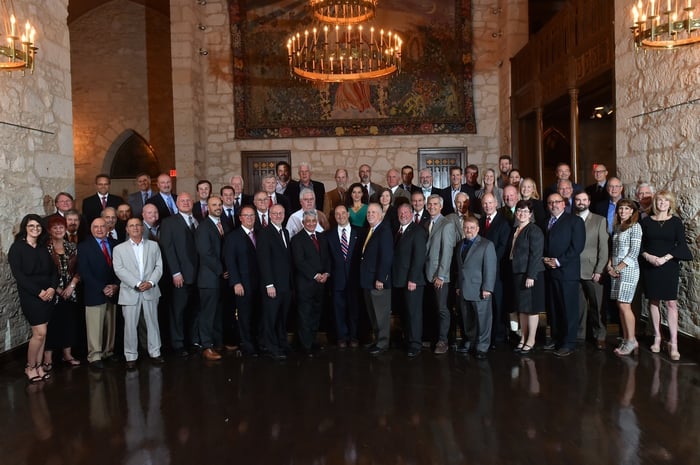
On October 26, 2017, Marlin Steel CEO Drew Greenblatt visited the San Antonio Manufacturer’s Association (SAMA) in Texas to speak with a group of Texas-based manufacturers about the current atmosphere of excitement in the manufacturing industry, the potential impacts of Trump’s tax plan for manufacturers, trade policy, and more.
Washington’s Misunderstanding of Manufacturing
One of the biggest challenges that manufacturing has had with politicians on Capitol Hill is that many politicians just don’t understand what modern manufacturing is like. As Drew said in his address to the SAMA event’s attendees:
“A lot of people in Washington, when we’ve had meetings with them, this is what they think of when they think of modern manufacturing: they think of this 1950’s picture from Pittsburgh with big smokestacks belching out smoke, [employers] not treating their employees well. That’s what most Washington politicians think of us. They’re wrong. They don’t know what’s going on with modern manufacturing. Another critical thing about most politicians in Washington—they don’t realize that most of us are small—they’re medium-sized. There are 229,000 manufacturers in America—over 227,000 of us are “peanuts,” they’re tiny. Most manufacturers have between 10 and 15 employees.”
Washington policymakers tend to think of manufacturers as gargantuan, monolithic organizations—ones full of dirty equipment where every task involves backbreaking labor that robs workers of their health and happiness.
This couldn’t be further from the truth about modern manufacturing companies. Most manufacturers are, as Drew pointed out, small to medium-sized businesses that have small teams and limited resources. In a modern factory, automated manufacturing equipment does the majority of the hard labor.
Fighting Poverty with Manufacturing
For many American workers, manufacturing represents a chance to fulfill the American dream and bring their family out of poverty. In his speech, Drew talked about a story that the New York Times wrote about one of Marlin’s employees, James Branch.
In his early life, Branch didn’t have many opportunities. He had dropped out of school after becoming a father at a young age. Later, he was arrested and sent to prison. After getting out, there weren’t many jobs available to him—so he ended up working a fryer at Popeye’s for minimum wage.
However, between shifts at Popeye’s, James set to work completing a two-year program in metalwork. Eventually, he was able to apply for a job with Marlin Steel.
Today, James makes over $20 an hour as a skilled machine operator for Marlin. The added income helped James break out of poverty and join the middle class—he has a home, a car, and was able to put his daughter through college using the money he made as a manufacturing worker.
This is one of the things that separates manufacturing jobs from other kinds of work—it helps build up people just as it helps build up the American economy.
Reworking Trade to Boost American Manufacturers
Trade is a crucial part of the American economy. 95% of the world’s consumers live outside of the USA’s borders. If American manufacturing is going to grow, then we need to have trade deals with other countries that give American businesses equal footing with their foreign competitors—not one-sided trade deals that have lopsided enforcement of intellectual property rights and other rules.
In his speech, Drew talks about the President’s move away from the TPP:
“The President has talked repeatedly about trade and how he’s going to take it differently from prior administrations. One of the first things he did was get out of the TPP—the Trans-Pacific Partnership—where we had 14 countries doing a deal… We talked to Vice President Pence about it. ‘Why, why would you get out of TPP?’ Vice President Pence explained it to me this way and it was a very compelling answer. He said that: ‘When we’re negotiating with 14 other countries, our heft, our power, our thrust, is minimized because we’re a smaller subset of the 14 countries. We instead want to cut a lot of deals that are bilateral deals, one-on-one deals. Why? Because, when we’re sitting down with Peru, we’re an 800-pound gorilla and they’ve got to cut a deal with us—we’re huge—but if we’re part of 14, we minimize our stature. And because of that, we can’t command as good a deal…’ That was their point of view.”
Previously, Marlin Steel has supported deals like the TPP on the basis of “it’s better than nothing at all.” However, the Trump Administration’s move is one that Marlin is hoping will lead to better deals by engaging in those one-on-one agreements, in which we can have more control and enforce a level playing field.
Giving Employees the Skills to Get Ahead
Toward the end of his speech before the gathered SAMA members, Drew discussed Marlin’s strategy for closing the skills gap and boosting productivity by using investing in employee training. A full 5% of Marlin’s payroll budget goes into employee development and training, so that everyone can have the skills they need to be ultra-productive, efficient, and safe.
Part of this strategy involved the creation of a job skills matrix—a public document with which everyone on the Marlin team can see skills that are in demand and who knows what. This encourages a fair amount of competition, as workers see who can master the most skills.
Learning new skills is also tied to permanent pay increases. The more important and difficult the skill is to master, the bigger the pay boost for the employee who masters it.
This training strategy is how Marlin closed the skills gap—making sure there are multiple team members who can do each job or run each machine so production doesn’t grind to a halt whenever the wrong person takes a much-deserved vacation.
Listen to the full podcast to get all of the insights that Drew shared at the exclusive SAMA event today!



.gif)


